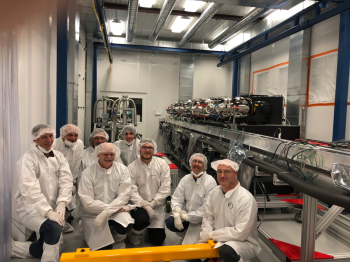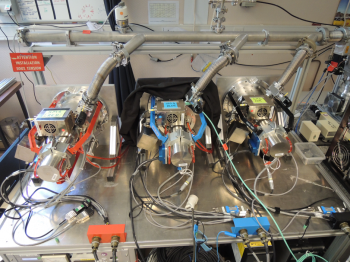The installation of DESI, the Dark Energy Spectroscopic Instrument at the Kitt Peak Observatory in Arizona, has just passed an important milestone: with 6 operational spectrographs on site, the minimum configuration required to meet the scientific objectives of the project has been reached. At the end, DESI will have 10 spectrographs and will commit itself from 2020 to the spectroscopic survey of 35 million galaxies and quasars, to study the dark component of the Universe. Irfu, responsible for the cryogenic part of the spectrographs, has made a major contribution to the success of this installation and is currently finalizing the qualification of the cameras of the last spectrograph in Saclay. In parallel, other essential milestones for the construction of the instrument are achieved.
With 6 spectrographs installed, DESI takes a new step forward
The installation of DESI at the 4 m Mayall Telescope is progressing in great strides. After the assembly and commissioning of two spectrographs last February (see April highlight), the Irfu technical team returned in early June to the Mayall telescope to install four new spectrographs with the valuable assistance and contribution of the telescope and Lawrence Berkeley National Laboratory (LNBL) teams (Fig. 1). This was followed by a phase of fine adjustment of the optical elements to ensure optimal focusing. As a result, the measured resolutions are remarkably homogeneous between the different spectrographs and better than the required specifications. With 6 spectrographs installed and fully operational, a key milestone for the success of DESI has been reached, as it ensures the minimum configuration for future observations, as defined by the US Department of Energy, the main funding agency for the project.

Figure 1: The Irfu team and their colleagues from the Mayall Telescope and LBNL Laboratory at the end of the installation of four additional complete spectrographs in the DESI instrument room at the telescope. The 6 spectrographs, installed on two superposed mounting frames, already form an impressive set (credits : DESI collaboration).

Figure 2: First image of the sky seen through the DESI field corrector and recorded by a set of six control cameras mounted (temporarily) on the corrector. This image of the Whirpool galaxy (Messier 51) shows the quality of the alignment and focusing of the six 1m diameter precision lenses that make up the corrector. The latter is intended to increase DESI's field of view to 8 square degrees (without distortions), 16 times larger than with the previous Mayall telescope (credit: DESI collaboration).
DESI's construction accelerates
In parallel with the previous work, the optics of the field corrector were tested and validated in the spring (Fig. 2) and the equipment of the focal plane of the instrument with fibres and positioning robots started at the end of June. One third of the focal plane is already covered, the rest will follow in July. In addition, the collaboration has just made available (see press release) the complete set of data required to define the 35 million target objects that DESI wants to observe: very bright galaxies, bright red galaxies, emission line galaxies and quasars.
Everything is therefore being set up for a DESI launch in the autumn. The first spectroscopic light is expected in October 2019 and will be followed by a commissioning period until January 2020. A program to validate the target selection and observation planning strategy will follow in February 2020, before the actual 5-year survey begins in the summer of 2020.
In Saclay, the qualification of the last cameras is in progress
The integration of the cameras of the remaining four spectrographs is well advanced. After assembly and validation in Saclay, the cameras of spectrographs 7 and 8 were delivered to Winlight Optics, the French company in charge of building DESI's spectrographs. The integration of the cameras and the complete optical characterization of the spectrograph-camera chain are completed for spectrograph 7, which is ready to be sent to the Mayall telescope. The optical qualification of spectrograph 8 is in progress.
In Saclay, the assembly of the cameras (field lens and CCD detector assembly in their cryostat) and the validation tests (cold descent, vacuum tests, CCD alignment, gain and noise measurements on the CCDs) are completed for spectrograph 9 (Fig. 3) and the assembly of the spectrograph 10 cameras has started. The delivery of the cameras of spectrograph 9 to Winlight Optics is scheduled for the end of August, the delivery of the cameras of the last spectrograph a month later. All ten spectrographs are expected to be operational in Kitt Peak by mid-November.
Contacts: Pierre-Henri Carton (Dedip), Christophe Magneville (DPhP), Vanina Ruhlmann-Kleider (DPhP)

Figure 3: Photo of the DESI camera test bench in Saclay during the validation of unit 4. The cameras for the three spectrograph channels (red, blue and infrared, from left to right) are mounted on the bench, pumped and ready for various tests (thermal, alignment verification, CCD characterization under illumination) (credit: DESI/Irfu).
• Structure and evolution of the Universe › Dark Universe
• Institute of Research into the Fundamental Laws of the Universe • The Electronics, Detectors and Computing Division • The Particle Physics Division • The Systems Engineering Division
• BAO
